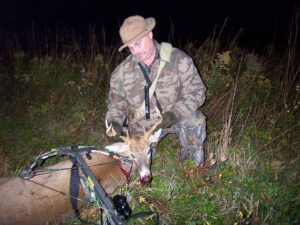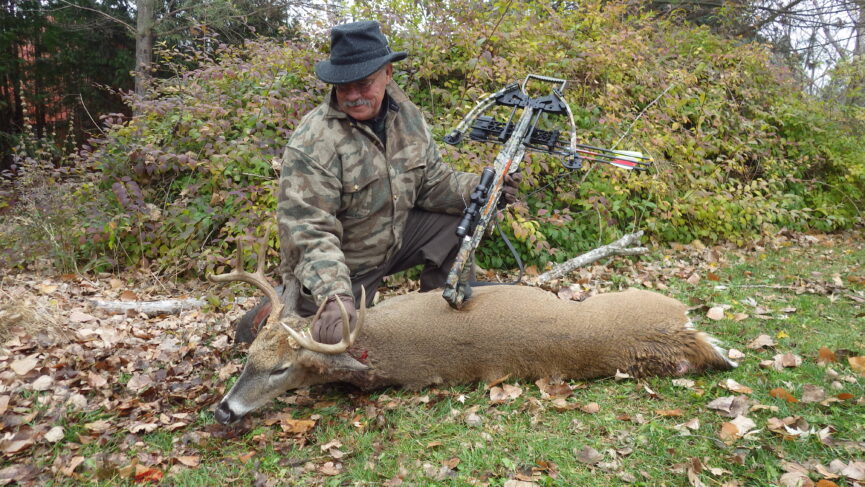
author with harvested w/Thumb-area buck
The first day of October represents the start of Michigan’s archery deer season, and it is a long-awaited timeframe for a lot of avid bowhunters, me included. Often referred to as being “bow season”, it is an outdoor pastime I have enjoyed for over 60 years, and I have a lot of fine memories, as well as I’ve been able to witness an evolution of sorts, especially regarding gear and employed hunting techniques.
My first bow and arrows were something I crafted when I was a farm kid, using a green limb from our orchard for the bow, chalk string for the bowstring, and just the right diameter willow twigs became the arrows. The system worked, sort of anyway, and I had some great times pretending to be Robin Hood and the farm orchard became my “Sherwood Forest”. I eventually saved up enough allowance to purchase a fiberglass recurve bow and wooden target arrows at the local hardware store, and due to plenty of practice at every opportunity, I became quite good with it. I even rigged up a small cardboard box stuffed with newspaper which I suspended from a tree limb using binder twine, and I could hit swinging matters with regularity at 25 yards.
My first bowhunt began using this bow and three wooden arrows tipped with “bodkin” broadheads, which I carried in a leather hip-quiver. And yep, folks, my first deer encounter with a bow in hand, has never been forgotten. You could only hunt on the ground back then, and I was seated with my back against a tree trunk, near a couple wild apple trees, when a forkhorn buck suddenly materialized just to my left only 10 yards away and stopped broadside. I automatically drew and released the arrow and watched it sail right over the buck’s back with a lot of daylight underneath it!
Well, folks, I can state I discovered right then that buck fever can hit you at the get-go, and I realized when you are shooting instinctively, it pays to focus on a small spot instead of the whole deer!
My next bow was a Bear recurve called a “Grizzly”, and my wooden arrows were tipped with “Bear Razorheads”, which would become my all-time favorite. The Grizzly recurve has 20 pounds more draw-weight than my old fiberglass bow and offered a faster and flatter trajectory. It remains to be a favorite bow of mine to this day and has accounted for its share of deer.
It was during the early 1980’s when the compound bow started to make a strong appearance, and most of my bowhunting friends traded their recurves in, and appreciated what they saw as advantages, especially the let-off factor when the compound bow was at full draw. This also allowed the use of accurate bow-sights which have become the norm today. I personally stuck to using traditional archery tackle, including adding a longbow into the mix, and I enjoyed doing tongue-in -cheek joking with my friends about using “training wheels” on their bows.
However, I can remember some dyed-in-the-wool bowhunters who took a more serious stance and claimed compound bows with pulleys and extra strings were going to be the ruination of bowhunting because it would make things so easy, that dedicated practice wouldn’t be required. Of course, such isn’t true, and I give the compound bow its full credit for making bowhunting more popular than ever. Every type of hunting arm requires dedicated practice to become proficient in the field.
Being able to bowhunt from tree stands and raised platforms would become legal in Michigan sometime during the early 1990’s (doing so with firearms became legal in 1997) which changed the complexion of bowhunting in the state. It has become the most popular hunting method used today, because it can be quite effective. However, it has become the number one cause of hunter injuries (including deaths). Safety harnesses have always been encouraged, but the early ones were a simple strap that was attached to the tree and then around the wearer’s torso, which could prove to be deadly if you fell, because it could constrict matters and suffocate the hunter.
An example is a friend of mine who had fastened the safety strap around his midsection, and when his tree stand collapsed, he had the sudden shocking stop when his safety strap reached its end which knocked the wind out of him, after which he found himself hanging upside down and unable to breathe. He was just losing consciousness when he managed to get his hunting knife out and cut the strap. He says that breaking his shoulder hurt like the dickens, but didn’t compare to the relief of being able to suck air back into his lungs!
Full body harnesses are the only safe way to go which applies the force of hitting the end of safety strap over a wider portion of the body and keeps the hunter upright. Some even come with special straps with breakaway stitching which can take some of the shock away. In any event, it is always wise to play it safe.

In 2007, due to an old shoulder injury and the resulting arthritis, I had to go to a compound bow, because the let-off factor allowed me to stay in the game. I had discovered that when your shoulder pops loud enough at full draw to scare deer away, it is time to reassess matters. Going from a traditional bow and instinctive shooting style to using a compound bow equipped with sights was a definite learning experience. I discovered right away that using a proper string-release created the best accuracy, and I was able to consistently keep tighter groups at greater ranges than I could with my traditional tackle. I would confidently take a dandy 10-point buck at 39-yards on October 1st that year, a range I probably wouldn’t have tried with traditional tackle. I had no problem bagging an October buck and a doe the following year (2008).
In the spring of 2009, the Michigan Natural Resources Commission allowed crossbows to used for deer hunting during the bow season, on a trial basis, to see how matters and acceptance worked with the overall hunting public, and it became a done deal in 2010. Some avid bowhunters were none too pleased with this move and claimed that it would be the ruination of bowhunting. Since I always like to try something new, I soon had a Darton crossbow and was amazed at its performance and deadly accuracy, and yep, folks, if you know how to accurately shoot a rifle, it doesn’t take long at all to get proficient with a crossbow. During the first week of the bow season that year, I dropped a nice 8-point buck at 42-yards. I could have readily done the same deed with my compound bow, but being able to use a shooting stick made it a precise shot.
Like the compound bow, the crossbow has brought out an increasing number of bow season participants, and it puts everyone, including kids, on a level playing field.
Yep, folks, all that archery stuff works for me!
- Fickle weather during December deer hunting adventures - December 3, 2025
- Michigan’s most popular opening day – November 15th - November 23, 2025
- A missing dog found while anticipating opening day - November 23, 2025

